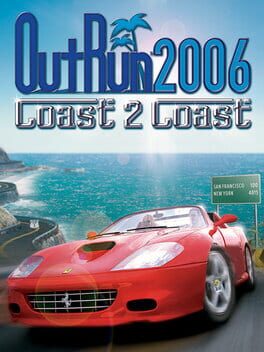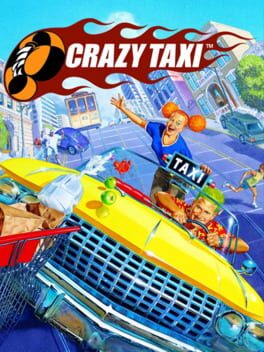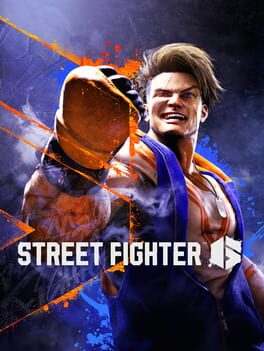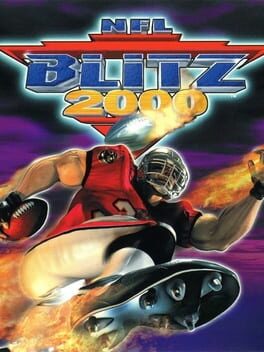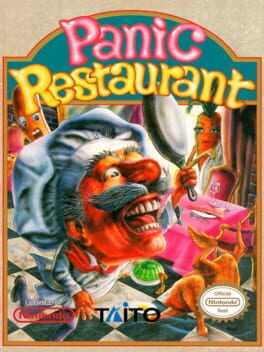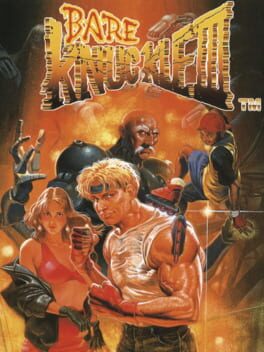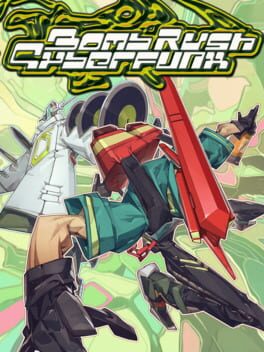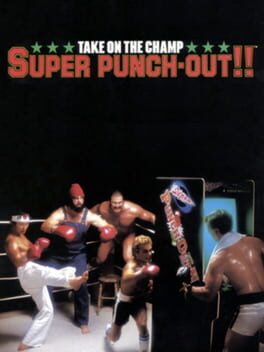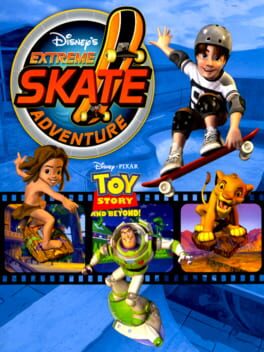6PMinHell
BACKER
115 Reviews liked by 6PMinHell
"Try to get as many 'HEARTS' as possible by meeting your girlfriend's demands."
In my review for the original OutRun, I referred to the game as an "i-15 simulator." Its distinctly Californian vistas and the frequency in which you pay witness to the most horrific car crashes imaginable rouse fond memories of nearly losing my life repeatedly on trips to and from my grandparent's home in Orange. Oh good, it was just a bus full of tourists that collided with a semi-truck and overturned, not me. Whew. Think I'll stop off for some McDonalds and pay triple the normal value for fries.
The original OutRun is a near-perfect simulacrum of this experience, and so it goes without saying that OutRun 2006's improved fidelity and more fluid controls provides a more accurate translation of that unique vibe. As with OutRun, your journey begins along the shore and branches out along one of several routes towards the more mountainous regions of California, and it's for this reason I picked it as one of the last games to play during my 2023 Summah Games series. It represents the trip back home. The vacation is over, it's time to leave the beaches and boardwalks behind and begin that long, harrowing trek back towards the drudgery of your everyday life - back to work and responsibilities, to the tired and familiar. It's the victory lap, and one last taste of Summah.
While the Shadow the Hedgehog-esque progression system accounts for a significant chunk of OutRun's replay value, Coast 2 Coast introduces a slew of additional modes and unlockables to pad out the game. Thankfully, a lot of this side content is worthwhile, and I personally found Heart Attack mode to be one of the more enjoyable parts of the game. In Heart Attack, you have to meet your girlfriend's "demands" in order to win her affection in addition to juggling your overall time. Girlfriends, am I right? All they do is nag, nag, nag. "Baby, take the trash out. Baby, you need to pay your bills. Baby, collect all the coins while drifting between traffic." Ugh. The ol' ball and chain...
The only real problem I had with OutRun 2006 is one that is uniquely me. I've spoken before about how I've been playing most PS2 games off a hard drive, and whether I just grabbed a bad dump of the game or there's some issue with the way Coast 2 Coast is being read in general, the soundtrack would not play for me at all. This is kind of a big deal, as anyone familiar with OutRun as a series would probably tell you. Listening to the radio is not only a major part of tying these games to the experience of racing through California, but the soundtrack is just really damn good. I resorted to playing the OST on my laptop, so this wasn't a total loss, but playing a deconstructed OutRun is less than ideal. Maybe I'll shell out 60$ for a used copy one day, but I'm not sure I like OutRun 2006 that much.
I'm going to eschew the Summah Index Scale for this one and say that the science on it is settled already. Probably for the best, as I've run out of goofy vehicle based "tests." Scraped the bottom of that barrel so hard I've broken through. Buncha bones on the other side... Concerning, but let's not dwell on that.
Not only is this patently Summah, but I can also see it entering into my annual rotation of games as something I can end the season on. That "trip back home" is just too perfect, and it is not something I am content with experiencing only once.
In my review for the original OutRun, I referred to the game as an "i-15 simulator." Its distinctly Californian vistas and the frequency in which you pay witness to the most horrific car crashes imaginable rouse fond memories of nearly losing my life repeatedly on trips to and from my grandparent's home in Orange. Oh good, it was just a bus full of tourists that collided with a semi-truck and overturned, not me. Whew. Think I'll stop off for some McDonalds and pay triple the normal value for fries.
The original OutRun is a near-perfect simulacrum of this experience, and so it goes without saying that OutRun 2006's improved fidelity and more fluid controls provides a more accurate translation of that unique vibe. As with OutRun, your journey begins along the shore and branches out along one of several routes towards the more mountainous regions of California, and it's for this reason I picked it as one of the last games to play during my 2023 Summah Games series. It represents the trip back home. The vacation is over, it's time to leave the beaches and boardwalks behind and begin that long, harrowing trek back towards the drudgery of your everyday life - back to work and responsibilities, to the tired and familiar. It's the victory lap, and one last taste of Summah.
While the Shadow the Hedgehog-esque progression system accounts for a significant chunk of OutRun's replay value, Coast 2 Coast introduces a slew of additional modes and unlockables to pad out the game. Thankfully, a lot of this side content is worthwhile, and I personally found Heart Attack mode to be one of the more enjoyable parts of the game. In Heart Attack, you have to meet your girlfriend's "demands" in order to win her affection in addition to juggling your overall time. Girlfriends, am I right? All they do is nag, nag, nag. "Baby, take the trash out. Baby, you need to pay your bills. Baby, collect all the coins while drifting between traffic." Ugh. The ol' ball and chain...
The only real problem I had with OutRun 2006 is one that is uniquely me. I've spoken before about how I've been playing most PS2 games off a hard drive, and whether I just grabbed a bad dump of the game or there's some issue with the way Coast 2 Coast is being read in general, the soundtrack would not play for me at all. This is kind of a big deal, as anyone familiar with OutRun as a series would probably tell you. Listening to the radio is not only a major part of tying these games to the experience of racing through California, but the soundtrack is just really damn good. I resorted to playing the OST on my laptop, so this wasn't a total loss, but playing a deconstructed OutRun is less than ideal. Maybe I'll shell out 60$ for a used copy one day, but I'm not sure I like OutRun 2006 that much.
I'm going to eschew the Summah Index Scale for this one and say that the science on it is settled already. Probably for the best, as I've run out of goofy vehicle based "tests." Scraped the bottom of that barrel so hard I've broken through. Buncha bones on the other side... Concerning, but let's not dwell on that.
Not only is this patently Summah, but I can also see it entering into my annual rotation of games as something I can end the season on. That "trip back home" is just too perfect, and it is not something I am content with experiencing only once.
Indigo Prophecy
2005
Indigo Prophecy
2005
Crazy Taxi
1999
Crazy Taxi
1999
Street Fighter 6
2023
i was originally gonna log this when i played & beat the single player but yeah it's gonna be a while before i even touch that.
had it since a few days after it's launch & i've put like 35 hours into online (ik not the most hardcore fighting game player) & yeah it's the 2nd best fighting game ever after 3rd strike.
had it since a few days after it's launch & i've put like 35 hours into online (ik not the most hardcore fighting game player) & yeah it's the 2nd best fighting game ever after 3rd strike.
The Outfoxies
1995
What a cool game! An early example of a platformer fighter tied to a very fun comic book/cinematic aesthetic. For as fun as the high-concept characters are - hard not to love "chimpanzee TV star who is also a contract killer" or "formerly-conjoined twin 11-year-olds... who are contract killers", the real stand-outs are the stages: huge, dynamic, and full of so many little details to keep longer matches constantly interesting. Especially for the era, the sheer amount of STUFF going on is quite impressive. My main complaint is that it's sometimes hard to keep track of what's going on - for as impressive as the sprite-scaling effect is, it does lend itself to readability issues on maps like the weapons factory or the circus tent. But that honestly strikes me as more a limitation of its era, and something that would have a ready solution if this was ever remade.
NFL Blitz 2000
1999
Panic Restaurant
1992
I have spent way too long debating whether to start this review by bringing up the insane prices this game goes for on online marketplaces, making fun of the DISGUSTING cover art, or joke about how it is basically Pizza Tower released 30 years earlier. So, after thinking it over… I decided to do all three of them at once. So yeah, anyway, Panic Restaurant is basically your typical NES game that was released pretty late into the console’s lifespan, and as per usual with games released this late into the console’s life span, it now goes for a FUCK TON of money, with prices ranging from around 500 US dollars to 5,000 US dollars online, even if, judging by what the cover art looks like, you’d wanna throw that thing in the microwave so it can melt away forever. That didn’t stop it from being a rare item to get for collectors, which is without a doubt the sole reason why some may remember the game fondly to this day. But, with that being said, does the game itself make up for the insane price that you would have to pay for it? Of fucking course not, but, if you were to “legally” play the game online, would it be worth seeking out? Honestly, yeah, I’d say so. It is a pretty enjoyable platformer, which doesn’t do anything new really for the genre, but manages to provide a charming, unique, and loveable experience for the time it came out, that I’m sure any fan of the genre could enjoy, or for those who are a fan of Pizza Tower, since this game is literally that game.
The story is pretty much the exact same that one game we have mentioned several times already, where your restaurant is cursed and threatened to be destroyed by an evil man named Ohdove, who is basically just Waluigi before he even existed, the graphics are really well done, having a lot of detail and expressiveness for all the enemies and characters, while also having a nice looking style that makes you wanna keep on going to see what else you can see in the game, the music is pretty good, with the tracks themselves not being that complex or different from other games, but it is very enjoyable to bob your head to, and it aids the tone that the game is going for, the control is solid all around, with no real problems to be found, and the gameplay is a recipe that ends up creating your typical NES dish, but it is seasoned with a hint of charm and personality that makes it a joy to dig into.
The game is your typical 2D platformer, where you take control of Cookie (yes, that is his actual name), take on a set of stages themed around the places you would typically associate with the kitchen and… eating outside, I guess, taking out plenty of enemies themes after food, cooking utensils, and whatever else the game decides to throw at you, gather plenty of different weapons, coins, health items, and extra lives along the way to help you out, and take on plenty of big bosses also themed around plenty of foods and cooking utensils. In addition to all of this, there are also plenty of bonus games that you can take on as well, such as a slot machine you can spend your coins on to get more health, points, and extra lives, and there are separate minigames that can be played throughout the levels, which usually result in you only getting a set amount of points depending on how well you do, but they can be a nice distraction when you run into them.
From that description I just gave, it all seems like your stereotypical NES platformer, and for the most part, you would be right, but what makes this one so charming and enjoyable is the kitchen and food theme that the game has throughout. It isn’t necessarily an original theme for a game, a level, or what have you, but it does add a level of charm to the game that makes it so much more likable and endearing in the process, at least for me, and this is amplified more with the characters themselves. For the time it was made, and the console it was released on, Cookie himself has many different expressions, which add to the goofy tone that this game is going for, and again, makes it all that more likable, and some of the enemies also get multiple expressions as well, with the bosses in particular getting the better end of that treatment… sometimes.
As a whole, Panic Restaurant doesn’t have any real issues that hold it back, as it is a fairly solid game. Sure, it may not last that long, but then again, there is nothing wrong with a quick and easy enough game that you can run through if you got nothing better to do. I guess the only real problem I can see people having with it at the end of the day is that, despite its endearing nature, it is still extremely basic. Many other games on the system have done what this game does, and it doesn’t really give anyone a reason to play it if they haven’t already played any other similar game on the NES. There is a reason why people only know this game for the insane prices it goes for online, because in terms of gameplay, there is nothing new or unique to offer, which doesn’t diminish its quality for me, but I imagine it can definitely do that for others.
Overall, despite its lack of originality in the gameplay department, this is still a pretty decent and fun platformer for the NES that I am happy that I finally checked out, and one that I would definitely like to replay at some point later down the road, just for the sake of revisiting it. I would definitely recommend it for those who are fans of the system, or fans of platformers in general, but for those who aren’t too big into either of those, then you really aren’t missing out on much. Really, just go play Pizza Tower at the end of the day if you want something new, creative, and game-changing. Yeah, it may be unfair to compare that game with this one, but seeing as how Cookie and Peppino are literally the same character, I see no problem in this.
Game #338
The story is pretty much the exact same that one game we have mentioned several times already, where your restaurant is cursed and threatened to be destroyed by an evil man named Ohdove, who is basically just Waluigi before he even existed, the graphics are really well done, having a lot of detail and expressiveness for all the enemies and characters, while also having a nice looking style that makes you wanna keep on going to see what else you can see in the game, the music is pretty good, with the tracks themselves not being that complex or different from other games, but it is very enjoyable to bob your head to, and it aids the tone that the game is going for, the control is solid all around, with no real problems to be found, and the gameplay is a recipe that ends up creating your typical NES dish, but it is seasoned with a hint of charm and personality that makes it a joy to dig into.
The game is your typical 2D platformer, where you take control of Cookie (yes, that is his actual name), take on a set of stages themed around the places you would typically associate with the kitchen and… eating outside, I guess, taking out plenty of enemies themes after food, cooking utensils, and whatever else the game decides to throw at you, gather plenty of different weapons, coins, health items, and extra lives along the way to help you out, and take on plenty of big bosses also themed around plenty of foods and cooking utensils. In addition to all of this, there are also plenty of bonus games that you can take on as well, such as a slot machine you can spend your coins on to get more health, points, and extra lives, and there are separate minigames that can be played throughout the levels, which usually result in you only getting a set amount of points depending on how well you do, but they can be a nice distraction when you run into them.
From that description I just gave, it all seems like your stereotypical NES platformer, and for the most part, you would be right, but what makes this one so charming and enjoyable is the kitchen and food theme that the game has throughout. It isn’t necessarily an original theme for a game, a level, or what have you, but it does add a level of charm to the game that makes it so much more likable and endearing in the process, at least for me, and this is amplified more with the characters themselves. For the time it was made, and the console it was released on, Cookie himself has many different expressions, which add to the goofy tone that this game is going for, and again, makes it all that more likable, and some of the enemies also get multiple expressions as well, with the bosses in particular getting the better end of that treatment… sometimes.
As a whole, Panic Restaurant doesn’t have any real issues that hold it back, as it is a fairly solid game. Sure, it may not last that long, but then again, there is nothing wrong with a quick and easy enough game that you can run through if you got nothing better to do. I guess the only real problem I can see people having with it at the end of the day is that, despite its endearing nature, it is still extremely basic. Many other games on the system have done what this game does, and it doesn’t really give anyone a reason to play it if they haven’t already played any other similar game on the NES. There is a reason why people only know this game for the insane prices it goes for online, because in terms of gameplay, there is nothing new or unique to offer, which doesn’t diminish its quality for me, but I imagine it can definitely do that for others.
Overall, despite its lack of originality in the gameplay department, this is still a pretty decent and fun platformer for the NES that I am happy that I finally checked out, and one that I would definitely like to replay at some point later down the road, just for the sake of revisiting it. I would definitely recommend it for those who are fans of the system, or fans of platformers in general, but for those who aren’t too big into either of those, then you really aren’t missing out on much. Really, just go play Pizza Tower at the end of the day if you want something new, creative, and game-changing. Yeah, it may be unfair to compare that game with this one, but seeing as how Cookie and Peppino are literally the same character, I see no problem in this.
Game #338
Bare Knuckle III
1994
I'm a Streets of Rage 3 apologist (it has a kangaroo), but after repeatedly being told the unbastardized Bare Knuckle III is the superior version in every way, I figured I had to give it a try. As it happens my repro guy wholesaler of legitimate Sega products happened to have an English patched version of the game. It even lights up! Like, really bright. Looks like the cart is reaching criticality in my Genesis.
I tried to replay a bit of Streets of Rage 3 so I could have a direct point of comparison between the two versions, and some differences were immediately apparent. Take Ash, for example. He's a mini-boss appearing in the first level of Bare Knuckle III that was cut from Streets of Rage 3 due to being an offensive leather daddy stereotype. At least that's the reason that's been given and repeated for years, and I can certainly see how it holds water as Ash does read like the butt of a joke.
There's a multitude of other differences both big and small, but the majority manifest in tweaks to difficulty balancing. Bare Knuckle III seems easier overall and much faster compared to its American counterpart, which was so difficult I could only push through it with a second player and a generous amount of save states. Comparatively, Bare Knuckle III took me one credit and about 45 minutes with the majority of my deaths being to the bulldozer, which I forgot I could push back with my fists - my bare knuckles as it were. That's really on me, and even with one measly life left, I was still able to complete the rest of the game. It's just a way smoother experience overall and makes it a lot harder to recommend Streets of Rage 3 to anyone who wants to play through the trilogy.
Unfortunately, I had to forcefully remove the Bare Knuckle III cart with my bare hands before it vaporized us all, exposing me to over a 1,000 rads. It won't be much longer now before radiation poisoning ravages my body. Please take a piece of chalk and mark where you're standing. Farewell.
I tried to replay a bit of Streets of Rage 3 so I could have a direct point of comparison between the two versions, and some differences were immediately apparent. Take Ash, for example. He's a mini-boss appearing in the first level of Bare Knuckle III that was cut from Streets of Rage 3 due to being an offensive leather daddy stereotype. At least that's the reason that's been given and repeated for years, and I can certainly see how it holds water as Ash does read like the butt of a joke.
There's a multitude of other differences both big and small, but the majority manifest in tweaks to difficulty balancing. Bare Knuckle III seems easier overall and much faster compared to its American counterpart, which was so difficult I could only push through it with a second player and a generous amount of save states. Comparatively, Bare Knuckle III took me one credit and about 45 minutes with the majority of my deaths being to the bulldozer, which I forgot I could push back with my fists - my bare knuckles as it were. That's really on me, and even with one measly life left, I was still able to complete the rest of the game. It's just a way smoother experience overall and makes it a lot harder to recommend Streets of Rage 3 to anyone who wants to play through the trilogy.
Unfortunately, I had to forcefully remove the Bare Knuckle III cart with my bare hands before it vaporized us all, exposing me to over a 1,000 rads. It won't be much longer now before radiation poisoning ravages my body. Please take a piece of chalk and mark where you're standing. Farewell.
"The test is over. From this moment on, you are a Raven."
To think it has been this long since I first heard those words spoken to me over 25 years ago, the day I completed my test to acquire what I had trained so hard for. To become a pilot of a mechanized terror, putting my neck on the line for some cash that entirely goes towards making my mechanical monster grow. The smell of freshly burnt steel from my energized blade slicing the enemy in two, my urge for battle only getting stronger with each successful victory and defeat that I manage to survive, it's a high that I can never get enough of. I'm just a servant, I'll go where the circle of cash flow takes me, it's only a job after all. It's nothin' personal, but it is my pleasure.
....however... work slowed down, and suddenly it seemed my services were no longer needed.
For over a decade, I stood idly by as the call for Ravens went silent as the night and I stared at my empty messages, desperation kicking in as I look towards other unsavory methods to keep my urges in check to no avail. What has happened? Were we made obsolete? What caused the interest to plummet so terribly? What am I to do? All I know is the thrill of robotic combat, I just can't understand it. How can my employer From Software just throw me away like this? I suppose they, and the world...didn't want us anymore. That's it then, guess you just can't beat the institute...
Then it happened.
I heard the notification. It was time to dust off my AC and get to work again...at long last after a decade of waiting, my calling in life has finally found me once more. My enemies will cower in fear as they hear my boosters approach as I barrel towards them like the devil that I am, my thirsty energized blade will find opponents to decimate into bits and pieces, and my gatling gun will have a reason to fire beyond just being a number that gets subtracted from my paycheck. This black and white world, screams for me to be the color red once more.....
With such a long and brutally boring pause in work, I'm surprised to find new blood amongst the ranks...greetings my newly born Fireflies of Rubicon 3... what shall I expect of you? Will you walk with the reapers, or burn with the saints? I look forward to sparring with you all.....I will see you in the Nest my brothers, sisters, and siblings...
Ten years was a long time to wait for more work...whatever it takes...whether it be ten, twenty or thirty years to get the next assignment after this, I will be waiting.....
.....and hungry for more......
....follow the buzzards....
To think it has been this long since I first heard those words spoken to me over 25 years ago, the day I completed my test to acquire what I had trained so hard for. To become a pilot of a mechanized terror, putting my neck on the line for some cash that entirely goes towards making my mechanical monster grow. The smell of freshly burnt steel from my energized blade slicing the enemy in two, my urge for battle only getting stronger with each successful victory and defeat that I manage to survive, it's a high that I can never get enough of. I'm just a servant, I'll go where the circle of cash flow takes me, it's only a job after all. It's nothin' personal, but it is my pleasure.
....however... work slowed down, and suddenly it seemed my services were no longer needed.
For over a decade, I stood idly by as the call for Ravens went silent as the night and I stared at my empty messages, desperation kicking in as I look towards other unsavory methods to keep my urges in check to no avail. What has happened? Were we made obsolete? What caused the interest to plummet so terribly? What am I to do? All I know is the thrill of robotic combat, I just can't understand it. How can my employer From Software just throw me away like this? I suppose they, and the world...didn't want us anymore. That's it then, guess you just can't beat the institute...
Then it happened.
I heard the notification. It was time to dust off my AC and get to work again...at long last after a decade of waiting, my calling in life has finally found me once more. My enemies will cower in fear as they hear my boosters approach as I barrel towards them like the devil that I am, my thirsty energized blade will find opponents to decimate into bits and pieces, and my gatling gun will have a reason to fire beyond just being a number that gets subtracted from my paycheck. This black and white world, screams for me to be the color red once more.....
With such a long and brutally boring pause in work, I'm surprised to find new blood amongst the ranks...greetings my newly born Fireflies of Rubicon 3... what shall I expect of you? Will you walk with the reapers, or burn with the saints? I look forward to sparring with you all.....I will see you in the Nest my brothers, sisters, and siblings...
Ten years was a long time to wait for more work...whatever it takes...whether it be ten, twenty or thirty years to get the next assignment after this, I will be waiting.....
.....and hungry for more......
....follow the buzzards....
Suzuki Bakuhatsu
2000
Cinematic puzzlery before we were ready. Suzuki Bakuhatsu astounds with its production values, abound with turn of the millennium photography, set dressing, apparel, and unbridled contentment. For as harrowing as the premise is, that the mundane has been overtaken by sophisticated explosives, the often devil-may-care attitude of Rin Ozawa's character suggests a subconscious understanding that this danger could never really happen. This is a world before the War on Terror, before we were made to feel unsafe by government and terrorists alike. Why not watch a bomb defusal expert hurriedly carry out her craft on stage, how could the worst possibly come to pass?
These vague plot points and extensive production are indicative of Sol and Enix's attempt to break the conventions of the stagnant puzzle genre. Tetris and Panel de Pon with new coats of paint were not enough. Kula World and iQ weren't thinking big enough. If the medium was to mature into a legitimate mode of storytelling (or at least entertainment) it needed bombast across all genres. The puzzle game could (and is shown to be) so much more than the puzzles themselves. It can be as tense as a thriller, as lighthearted as a situation comedy. Yet the puzzles too remain a highlight, with fully realised, complexly nesting polygonal designs which are explored in the round in a step above Resident Evil or Skyrim. The bombs are as the puzzle boxes seen in Fireproof Games' The Room, a series of self-affecting pieces, more involved than they let on. Suzuki Bakuhatsu simply would not work in a two-dimensional space.
Tomoyuki Tanaka's shibuya-kei interstitial compositions are as much a highlight as Rin Ozawa's humming during defusal, and the cast and crew are dripping with talent. On the variety show Suzuki inexplicably becomes a part of, we see Yukiko Ehara and YOU THE ROCK★ flanking Minami Shirakawa. Asami Imajuku, Haruichiban, and Kiyohiko Shibukawa make surprise appearances as well. Though not quite a who's-who of the Japanese entertainment industry, these familiar faces (especially two decades after release) demonstrate that Suzuki Bakuhatsu was all about bombast. In a world before Portal and Catherine, however, perhaps we were unprepared to accept that puzzle games could be something more.
These vague plot points and extensive production are indicative of Sol and Enix's attempt to break the conventions of the stagnant puzzle genre. Tetris and Panel de Pon with new coats of paint were not enough. Kula World and iQ weren't thinking big enough. If the medium was to mature into a legitimate mode of storytelling (or at least entertainment) it needed bombast across all genres. The puzzle game could (and is shown to be) so much more than the puzzles themselves. It can be as tense as a thriller, as lighthearted as a situation comedy. Yet the puzzles too remain a highlight, with fully realised, complexly nesting polygonal designs which are explored in the round in a step above Resident Evil or Skyrim. The bombs are as the puzzle boxes seen in Fireproof Games' The Room, a series of self-affecting pieces, more involved than they let on. Suzuki Bakuhatsu simply would not work in a two-dimensional space.
Tomoyuki Tanaka's shibuya-kei interstitial compositions are as much a highlight as Rin Ozawa's humming during defusal, and the cast and crew are dripping with talent. On the variety show Suzuki inexplicably becomes a part of, we see Yukiko Ehara and YOU THE ROCK★ flanking Minami Shirakawa. Asami Imajuku, Haruichiban, and Kiyohiko Shibukawa make surprise appearances as well. Though not quite a who's-who of the Japanese entertainment industry, these familiar faces (especially two decades after release) demonstrate that Suzuki Bakuhatsu was all about bombast. In a world before Portal and Catherine, however, perhaps we were unprepared to accept that puzzle games could be something more.
Bomb Rush Cyberfunk
2023
My first thought was that Bomb Rush Cyberfunk was just going to be a straight spiritual successor to Jet Set Radio Future (which would have been a letdown considering my three weeks of original Jet Set Radio prep), but I'm pleasantly surprised by the blend of mechanics presented! In reality, Bomb Rush Cyberfunk takes the overall structure and aesthetic from Future while borrowing more heavily from original Jet Set Radio's tight level design and intricate scoring mechanics, and dare I say, actually improves upon certain aspects. It does have a few underdeveloped features as a result of its experimentation, but overall, not a bad first attempt by Team Reptile!
One issue that apparently escaped my notice the first time around (I replayed Future recently just to confirm this) was that Future's extremely linear and stretched-out levels resulted in tons of backtracking upon missing objectives/falling off the stage, and led to fairly rigid approaches that really tried my patience upon additional loops. This is fortunately not the case with Bomb Rush Cyberfunk: levels are generally a lot more open with many more shortcuts and are spaced apart carefully to where traversal feels much more free-form. It more closely resembles original Jet Set Radio, especially when you consider how its momentum mechanics complement this design. Future made the speed fairly easy to obtain: jump onto a rail regardless of your momentum, then keep mashing trick to accelerate and never slow down. On the other hand, original Jet Set Radio became well-known for how slow your character would move about unless you actively utilized rails and grindable walls to speed up, and Bomb Rush Cyberfunk takes a modern twist: you need to maintain momentum by either rail grinding and leaning into corners for speed boosts, or by using grounded manuals combined with boost (refreshed from performing tricks) to retain speed.
The momentum mechanics go hand-in-hand with the game's combo system. After thoroughly exploring levels to spray graffiti spots for "rep" and completing subsequent score and movement-tech challenges from opposing crew members, your crew must finally confront opposing crews in a crew battle, outscoring them with trick combos in their own territory. The scoring and trick system improvises upon both original Jet Set Radio and Future: in both games, the safest way to score trick points was abusing infinite grind loops and repeating the same tricks/movement over and over. However, Bomb Rush Cyberfunk turns this on its head: you don't get tons of points for doing the same tricks ad-nauseam (since trick value decreases and eventually levels off when used more and more). Instead, the main key to getting points is increasing the multiplier by utilizing unique features of the stage: that is, leaning into tight corners on grindable rails, wall-riding billboards, and going up half-pipe ramps (which are improved over the original game since you can manual up ramps and then air boost off into manuals/rail and wall-grinds, so they can function as part of a combo). The key word is "unique," since utilizing the same set-piece in a held combo will not give additional multipliers, and the same goes for graffiti spots that can now also be resprayed as one-time trick bonuses during continuous combos. As a result, the trick and multiplier staling incentivizes players to fully explore and utilize every set-piece present upon the open stages to create massive combos, made easier thanks to the mid-air dash (which also lets you alter airborne momentum once) and the manual. The only downside here is that the game's circumstances never become difficult enough to necessitate this trick optimization; the story crew battles are pretty easy and I was leapfrogging them using the above strategy (i.e. while other crews were floundering around several hundred thousand, I was well beyond a couple million in score), so unless players are trying to crack the tougher post-game score barriers for optional characters/achievements, they may never need to lean on these strategies at all.
The lack of difficulty serves as a microcosm of this game's unfortunate trend: Bomb Rush Cyberfunk certainly innovates upon many features from the Jet Set Radio games, but I find a few to be undercooked or lacking in execution. The combat's one example: it's not a bad idea in theory (using tricks to both deal damage and maintain score/momentum) and in fact has been proposed before, but its implementation leaves something to be desired. Attacking enemies feels like it has little impact because of the muffled sound-effects, akin to slapping a wet sock on a table. Also, most enemies can be defeated with a single grounded attack into an immediate "corkscrew" jump and then spray-painted in the air. While this graffiti coup de grâce never gets old, it does feel quite difficult in practice comboing in and out of this linearizing technique (since you need to be standing and off your skates to execute, breaking any combo potential), so combat never really flows and the mandatory combat sections in-story feel somewhat superfluous.
Adjacent to this is the heat system, a spin on original Jet Set Radio's enemy escalation during story stages. As your character goes about spraying graffiti, police forces begin to spawn in tougher waves: for example, wave one consists of simple grounded officers with batons and pistols, wave two activates turrets that home-in on the player with chains and slow their movement, and wave three brings in armored forces that can block attacks. I found most of these enemies to be mere nuisances: you can easily skate around and dodge most attacks (except for the turrets, which can be easily disabled with a single attack + spray), and since enemies can't be easily comboed for points and will respawn continuously upon defeat anyways, it's best to just ignore them as is. Again, this is fairly similar to original Jet Set Radio's strategy of outmanuevering enemies since foes there were active time sinks, so this doesn't bother me greatly. Unfortunately, this creates friction with Bomb Rush Cyberfunk's exploration, and not just in the sense that enemies will impede progress. The game requires you to swap between the three different types of movestyle for their different abilities: skateboards can ride on extendable fire hydrants to extend them vertically and reach heights, inline skates can skid on glass to shatter specific ceilings, and bikes can open special garage doors. The only way to switch between characters/movestyles is to go to checkerboard tiles and dance, but the game prohibits switching when there's "too much heat." Thus, you have to de-escalate the heat gauge by entering orange porta-potties (unmarked on the map, so hopefully you remember their locations!). However, they also lock up after a single use, so players have to either outright leave the stages or find a different porta-potty elsewhere to reopen old porta-potties for enemy despawning. I think this could have easily been improved if the heat gauge slowly decreased over time from successful enemy evasion.
Even with my criticisms, Bomb Rush Cyberfunk was definitely worth the three year wait. The story isn't anything mindblowing, but it's got some nice twists that are conveyed via these surreal platforming sequences that are a cross between the time rifts from A Hat in Time and a Psychonauts fever dream. I'm pleasantly surprised by a good chunk of the soundtrack too: Hideki Naganuma's three contributions are the obvious highlights, but other tracks like 2Mello's I Wanna Kno and Sebastian Knight's Feel the Funk more than hold their own weight. It's a good mix of upbeat sampledelia hip-hop and chill ambient tunes, with my only real complaint being the lack of guitar-heavy rock tracks like Magical Girl or Statement of Intent... RIP Guitar Vader. Finally, I more than got my playtime's worth out of 100%ing the game, considering all the hidden areas and collectibles to find and just how much fun I had figuring out new ways to string together ridiculous combos. Despite the game's various areas of improvement, I find Bomb Rush Cyberfunk to be a fantastic fresh take upon a beloved franchise that isn't just a homage to Jet Set Radio, but a love letter to classic Y2K counter-culture and skating games as a whole. If you're not a prior fan of the franchise, this might not be the game to change your mind, but if you are, then I see no reason why you wouldn't find some enjoyment out of it. It's no surprise that fans absolutely ate this up, with excitement for the franchise reaching a new fever pitch. Your move, SEGA. Let's see if you guys still understand the concept of love.
One issue that apparently escaped my notice the first time around (I replayed Future recently just to confirm this) was that Future's extremely linear and stretched-out levels resulted in tons of backtracking upon missing objectives/falling off the stage, and led to fairly rigid approaches that really tried my patience upon additional loops. This is fortunately not the case with Bomb Rush Cyberfunk: levels are generally a lot more open with many more shortcuts and are spaced apart carefully to where traversal feels much more free-form. It more closely resembles original Jet Set Radio, especially when you consider how its momentum mechanics complement this design. Future made the speed fairly easy to obtain: jump onto a rail regardless of your momentum, then keep mashing trick to accelerate and never slow down. On the other hand, original Jet Set Radio became well-known for how slow your character would move about unless you actively utilized rails and grindable walls to speed up, and Bomb Rush Cyberfunk takes a modern twist: you need to maintain momentum by either rail grinding and leaning into corners for speed boosts, or by using grounded manuals combined with boost (refreshed from performing tricks) to retain speed.
The momentum mechanics go hand-in-hand with the game's combo system. After thoroughly exploring levels to spray graffiti spots for "rep" and completing subsequent score and movement-tech challenges from opposing crew members, your crew must finally confront opposing crews in a crew battle, outscoring them with trick combos in their own territory. The scoring and trick system improvises upon both original Jet Set Radio and Future: in both games, the safest way to score trick points was abusing infinite grind loops and repeating the same tricks/movement over and over. However, Bomb Rush Cyberfunk turns this on its head: you don't get tons of points for doing the same tricks ad-nauseam (since trick value decreases and eventually levels off when used more and more). Instead, the main key to getting points is increasing the multiplier by utilizing unique features of the stage: that is, leaning into tight corners on grindable rails, wall-riding billboards, and going up half-pipe ramps (which are improved over the original game since you can manual up ramps and then air boost off into manuals/rail and wall-grinds, so they can function as part of a combo). The key word is "unique," since utilizing the same set-piece in a held combo will not give additional multipliers, and the same goes for graffiti spots that can now also be resprayed as one-time trick bonuses during continuous combos. As a result, the trick and multiplier staling incentivizes players to fully explore and utilize every set-piece present upon the open stages to create massive combos, made easier thanks to the mid-air dash (which also lets you alter airborne momentum once) and the manual. The only downside here is that the game's circumstances never become difficult enough to necessitate this trick optimization; the story crew battles are pretty easy and I was leapfrogging them using the above strategy (i.e. while other crews were floundering around several hundred thousand, I was well beyond a couple million in score), so unless players are trying to crack the tougher post-game score barriers for optional characters/achievements, they may never need to lean on these strategies at all.
The lack of difficulty serves as a microcosm of this game's unfortunate trend: Bomb Rush Cyberfunk certainly innovates upon many features from the Jet Set Radio games, but I find a few to be undercooked or lacking in execution. The combat's one example: it's not a bad idea in theory (using tricks to both deal damage and maintain score/momentum) and in fact has been proposed before, but its implementation leaves something to be desired. Attacking enemies feels like it has little impact because of the muffled sound-effects, akin to slapping a wet sock on a table. Also, most enemies can be defeated with a single grounded attack into an immediate "corkscrew" jump and then spray-painted in the air. While this graffiti coup de grâce never gets old, it does feel quite difficult in practice comboing in and out of this linearizing technique (since you need to be standing and off your skates to execute, breaking any combo potential), so combat never really flows and the mandatory combat sections in-story feel somewhat superfluous.
Adjacent to this is the heat system, a spin on original Jet Set Radio's enemy escalation during story stages. As your character goes about spraying graffiti, police forces begin to spawn in tougher waves: for example, wave one consists of simple grounded officers with batons and pistols, wave two activates turrets that home-in on the player with chains and slow their movement, and wave three brings in armored forces that can block attacks. I found most of these enemies to be mere nuisances: you can easily skate around and dodge most attacks (except for the turrets, which can be easily disabled with a single attack + spray), and since enemies can't be easily comboed for points and will respawn continuously upon defeat anyways, it's best to just ignore them as is. Again, this is fairly similar to original Jet Set Radio's strategy of outmanuevering enemies since foes there were active time sinks, so this doesn't bother me greatly. Unfortunately, this creates friction with Bomb Rush Cyberfunk's exploration, and not just in the sense that enemies will impede progress. The game requires you to swap between the three different types of movestyle for their different abilities: skateboards can ride on extendable fire hydrants to extend them vertically and reach heights, inline skates can skid on glass to shatter specific ceilings, and bikes can open special garage doors. The only way to switch between characters/movestyles is to go to checkerboard tiles and dance, but the game prohibits switching when there's "too much heat." Thus, you have to de-escalate the heat gauge by entering orange porta-potties (unmarked on the map, so hopefully you remember their locations!). However, they also lock up after a single use, so players have to either outright leave the stages or find a different porta-potty elsewhere to reopen old porta-potties for enemy despawning. I think this could have easily been improved if the heat gauge slowly decreased over time from successful enemy evasion.
Even with my criticisms, Bomb Rush Cyberfunk was definitely worth the three year wait. The story isn't anything mindblowing, but it's got some nice twists that are conveyed via these surreal platforming sequences that are a cross between the time rifts from A Hat in Time and a Psychonauts fever dream. I'm pleasantly surprised by a good chunk of the soundtrack too: Hideki Naganuma's three contributions are the obvious highlights, but other tracks like 2Mello's I Wanna Kno and Sebastian Knight's Feel the Funk more than hold their own weight. It's a good mix of upbeat sampledelia hip-hop and chill ambient tunes, with my only real complaint being the lack of guitar-heavy rock tracks like Magical Girl or Statement of Intent... RIP Guitar Vader. Finally, I more than got my playtime's worth out of 100%ing the game, considering all the hidden areas and collectibles to find and just how much fun I had figuring out new ways to string together ridiculous combos. Despite the game's various areas of improvement, I find Bomb Rush Cyberfunk to be a fantastic fresh take upon a beloved franchise that isn't just a homage to Jet Set Radio, but a love letter to classic Y2K counter-culture and skating games as a whole. If you're not a prior fan of the franchise, this might not be the game to change your mind, but if you are, then I see no reason why you wouldn't find some enjoyment out of it. It's no surprise that fans absolutely ate this up, with excitement for the franchise reaching a new fever pitch. Your move, SEGA. Let's see if you guys still understand the concept of love.
Super Punch-Out!!
1984
Have you ever had the feeling where you just wanted to beat the fuck out of someone? Of course, you can’t really do that IRL without getting into some kind of trouble (in most circumstances, anyway), but thankfully, video games are there to help with that. Obviously, not all games involve violence, or necessarily beating people up, but games where the main goal is to beat down someone else trying to beat you down, especially in a professional manner, works pretty well, as seen previously with Punch-Out. The original arcade game, while not being too much nowadays, especially in comparison to the much more beloved console games, does still hold up really well, and was successful enough to where less then a year later, a “sequel” was made for the arcades known as “Super Punch-Out!!”.
Now, despite the fact that the game is a sequel to the original game, it is practically identical to the original game in many aspects. There are very few changes made to the game, and it could be seen as a precursor to DLC, so with that being said, I will treat the game as DLC rather then a full new sequel. If you wanna know my full thoughts about Punch-Out (and to an extent, this game), you can read my review on that game, but for you who don’t care about that, I will only discuss what this game changes compared to the original, and how it improves on it.
In terms of gameplay, it all remains pretty much the same, with the only real change being a new mechanic where you can now duck to avoid attacks that you wouldn’t be able to block or dodge. It is a pretty good technique, but you only really need to use it when it is absolutely necessary to use, so it just comes off as another step to winning a match. The main changes only come in the form of the new fighters you take on, as most would become recurring characters in the series. Each one of them are still pretty unique, having traits that make them stand out from each other, as well as moves that no other boxer before were able to pull off, such as kicks and spinning punches. And not to mention, their animations are very charming, and they still have standout, charming titles that will make you remember them, such as Bear Hugger, Super Macho Man, Vodka Drunkinski………… well, glad to see we still have consistency with names that don’t age well.
Aside from those things though, like I said, it is practically the exact same game as the original, which can be a reason people wouldn’t wanna check it out, which is understandable. I would still consider it to be pretty good, and when compared to the original, I would say this is the better of the two, due to having more movement then the original. Nevertheless, if you were to check out the original Punch-Out games, you only need to check out one of these two games, not both of them. Thankfully, the rest of the games in the series would differ somewhat, so this problem of repeating won’t become a common occurrence… at least, not to this extent.
Game #226
Now, despite the fact that the game is a sequel to the original game, it is practically identical to the original game in many aspects. There are very few changes made to the game, and it could be seen as a precursor to DLC, so with that being said, I will treat the game as DLC rather then a full new sequel. If you wanna know my full thoughts about Punch-Out (and to an extent, this game), you can read my review on that game, but for you who don’t care about that, I will only discuss what this game changes compared to the original, and how it improves on it.
In terms of gameplay, it all remains pretty much the same, with the only real change being a new mechanic where you can now duck to avoid attacks that you wouldn’t be able to block or dodge. It is a pretty good technique, but you only really need to use it when it is absolutely necessary to use, so it just comes off as another step to winning a match. The main changes only come in the form of the new fighters you take on, as most would become recurring characters in the series. Each one of them are still pretty unique, having traits that make them stand out from each other, as well as moves that no other boxer before were able to pull off, such as kicks and spinning punches. And not to mention, their animations are very charming, and they still have standout, charming titles that will make you remember them, such as Bear Hugger, Super Macho Man, Vodka Drunkinski………… well, glad to see we still have consistency with names that don’t age well.
Aside from those things though, like I said, it is practically the exact same game as the original, which can be a reason people wouldn’t wanna check it out, which is understandable. I would still consider it to be pretty good, and when compared to the original, I would say this is the better of the two, due to having more movement then the original. Nevertheless, if you were to check out the original Punch-Out games, you only need to check out one of these two games, not both of them. Thankfully, the rest of the games in the series would differ somewhat, so this problem of repeating won’t become a common occurrence… at least, not to this extent.
Game #226
